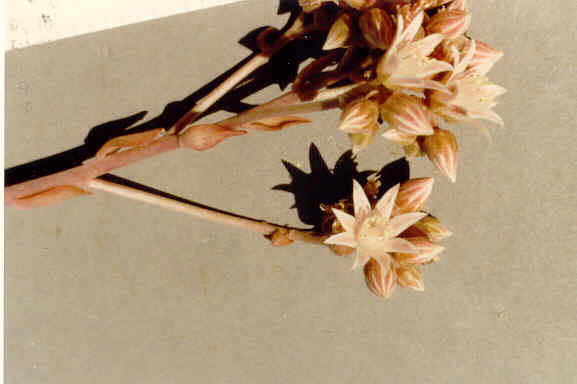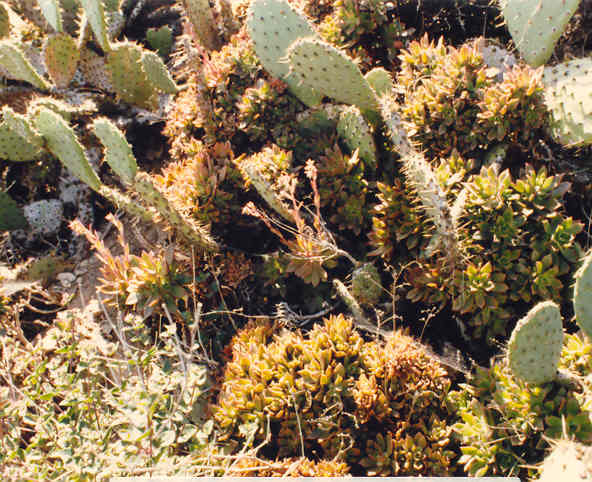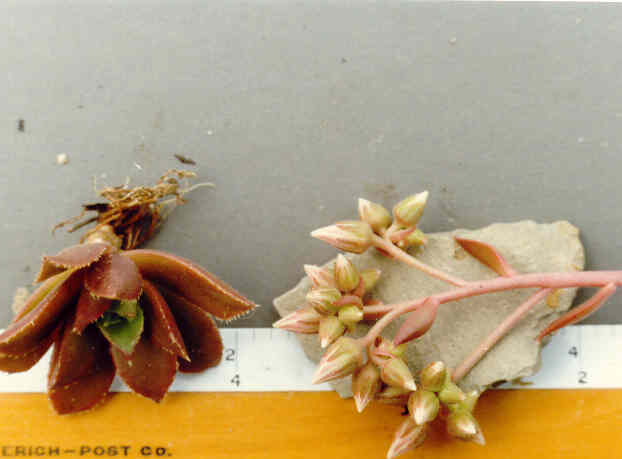
Aeonium haworthii Salm-Dyck
Crassulaceae (Orpine Family)
Canary Islands
 |
Aeonium haworthii Salm-DyckCrassulaceae (Orpine Family)Canary Islands
Aeonium |
May Photo
Plant Characteristics:
Fleshy subshrub, to 3-4 dm. tall in older specimens with many offsets,
older rosettes have stems; lvs. +/- 25 to a rosette, green, glabrous,
spatulate-oblanceolate, to 4 cm. long, 1.5 cm. wide, with a mucronate tip,
margins tinged dark red and with a few short white stout hairs less than 1 mm.
long, some appearing glandular; the first leafy flowering stem originates from
center of rosette, subsequent shoots, which may number, 2,3,4 or maybe more come
from below center but not from base of rosette, all 15-18 cm. tall; fls. in
cymose panicles; petals 8, narrow triangular, 10 mm. long, joined only slightly
at base, pink, spreading in upper half from campanulate lower half; calyx 8
parted, the segments slightly less than half as long as petals; stamens 16 in
two whorls; pistils 8, not connate at base.
(my description from live material, using Bailey as a guide).
Habitat:
Escape from cultivation; most likely thrown over the bank with yard
trimmings from the old Castaway's restaurant that burned about 1956. (my comment). Blooms
April-May. Hickman,
Ed. 524 indicates that the plant is found on sea cliff below 100 m. along the
south Coast. This information would
indicate that it is naturalized here. (my
comment).
Name:
Aeo-nium, dioscoridean synonym of AE.
arboreum. (Bailey 466). Haworthii,
for Adrian Hardy Haworth, 1768-1833,
England. (Bailey 44).
General:
Occurs in only one place in the study area and this on the Castaway's
Bluffs where it is well protected by a large acacia tree on the uphill side and
by Opuntia littoralis on the other
sides. (my comments).
Aeonium differs from Sempervivium
in that the rosettes have stems, the petals are not hairy or fringed and the
rosette leaves are not as dense. In
Sempervivum, the offsets develop, forming mounds against the ground.
The key to Sempervivum in Bailey does not list a species with 8 petals, it
lists those with 6-7 and 9-20 petals. Differs
from Echeveria in that the petals
spread from below the middle rather than at the tips.
Also, Aeonium petals are not
united into a tube as in Echeveria and
the flower stems are not axillary. (from
a letter by John Johnson 5/6/91).
About 36 species, cult. outdoors in warm-temp. regions, under glass in
cooler climates.
Text Ref:
Bailey 465.
Photo Ref:
March-April 87 #3; April 2 87 # 11A,12A,13A; May 1 87 # 7,8.
Identity: by R. De Ruff,
Genus identity confirmed by John Johnson.
First Found: March 1987.
Computer Ref: Plant Data 412.
Have plant specimen.
Last edit 3/4/05
 |
 |
March Photo April Photo